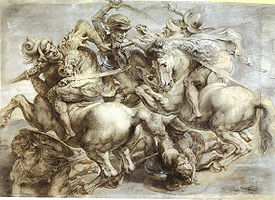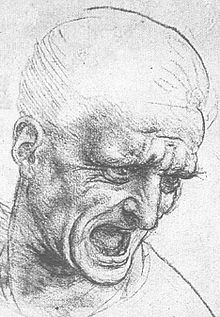- The Battle of Anghiari (painting)
-
 Peter Paul Rubens's copy of The Battle of Anghiari. Allegedly from left to right is Francesco Piccinino; Niccolò Piccinino; Ludovico Trevisan; Giovanni Antonio del Balzo Orsini.
Peter Paul Rubens's copy of The Battle of Anghiari. Allegedly from left to right is Francesco Piccinino; Niccolò Piccinino; Ludovico Trevisan; Giovanni Antonio del Balzo Orsini.
The Battle of Anghiari (1505) is a lost painting by Leonardo da Vinci at times referred to as "The Lost Leonardo", which some commentators believe to be still hidden beneath later frescoes in the Hall of Five Hundred (Salone dei Cinquecento) in the Palazzo Vecchio, Florence. Its central scene depicted three men riding raging war-horses engaged in a battle for possession of a standard, at the Battle of Anghiari in 1440.
Many preparatory studies by Leonardo still exist. The composition of the central section is best known through a drawing by Peter Paul Rubens in the Louvre, Paris. This work, dating from 1603 and known as The Battle of the Standard, was based on an engraving of 1553 by Lorenzo Zacchia, which was taken from the painting itself or possibly derived from a cartoon by Leonardo. Rubens succeeded in portraying the fury, the intense emotions and the sense of power that were presumably present in the original painting. Similarities have been noted between this Battle of Anghiari and the Hippopotamus Hunt painted by Rubens in 1616.
Contents
History
In 1504 Leonardo da Vinci was given the commission by gonfaloniere Piero Soderini, a contract signed by no less than Niccolò Machiavelli, to decorate the Hall of Five Hundred. At the same time his rival Michelangelo Buonarroti, who had just finished his David, was designated the opposite wall. This was the only time that Leonardo da Vinci and Michelangelo worked together on the same project. The painting of Michelangelo depicted an episode from the Battle of Cascina, when a group of bathing soldiers was surprised by the enemy. However Michelangelo did not stay in Florence long enough to complete the project. He was able to finish his cartoon, but only began the painting. He was invited back to Rome in 1505 by the newly appointed Pope Julius II and was commissioned to build the Pope's tomb.
Leonardo da Vinci drew his large cartoon in the Basilica di Santa Maria Novella, depicting a scene from the life of Niccolò Piccinino, a condottiere in the service of duke Filippo Maria Visconti of Milan. He drew a scene of a violent clash of horses and a furious battle of men fighting for the flag in the Battle of Anghiari. Giorgio Vasari in his book Le Vite praised the magistral way Leonardo had put this scene on paper: "It would be impossible to express the inventiveness of Leonardo's design for the soldiers' uniforms, which he sketched in all their variety, or the crests of the helmets and other ornaments, not to mention the incredible skill he demonstrated in the shape and features of the horses, which Leonardo, better than any other master, created with their boldness, muscles and graceful beauty."
Leonardo built an ingenious scaffold in the Hall of Five Hundred that could be raised or folded in the manner of an accordion. This painting was to be his largest and most substantial work. Since he had a bad experience with fresco painting (Last Supper; refectory of Santa Maria delle Grazie, Milan), he wanted to apply oil colours on the wall. He began also to experiment with such a thick undercoat (possibly mingled with wax), that after he applied the colours, the paint began to drip. Trying to dry the painting in a hurry and save whatever he could, he hung large charcoal braziers close to the painting. Only the lower part could be saved in an intact state. But the upper part couldn't dry fast enough and the colours intermingled. Leonardo then abandoned the project.
Michelangelo's and Leonardo's unfinished paintings hung in the same room together for almost a decade (1505-1512). The cartoon of Michelangelo's painting was cut in pieces by Bartolommeo Bandinelli out of jealousy in 1512. The centerpiece of The Battle of Anghiari was greatly admired and numerous copies were made for decades.
In the mid-16th century (1555-1572), the hall was enlarged and restructured by Vasari and his helpers, so that Grand Duke Cosimo I could hold his court in this chamber. During this transformation, famous (but unfinished) works were lost, including The Battle of Cascina by Michelangelo and The Battle of Anghiari by Leonardo da Vinci.
Possible recovery
Maurizio Seracini, an Italian expert in high-technology art analysis, believes that behind one of these murals by Vasari, the "Battle of Marciano in Val di Chiana" (1563), is hiding the original fresco of Leonardo da Vinci. On top of Vasari's fresco, 12 meters above the ground, a Florentine soldier waves a green flag with the words "Cerca trova" ("He who seeks, finds"). These enigmatic words seem to be a hint by Vasari, who always spoke highly of the fresco of Leonardo da Vinci.
Seracini believes it is unlikely that Vasari would have destroyed the work of his predecessor during his renovation of the Hall of Five Hundred. Using non-invasive techniques, such as a high-frequency, surface-penetrating radar and thermographic camera, Seracini made a survey of the hall. Among other conclusions, he found out that Vasari had built another wall in front of the east wall where the original fresco of Leonardo da Vinci was reported to be located. He found a gap of 1 to 3 centimeters between the two walls, large enough for the older fresco to be preserved.
Since early 2007, the city council of Florence and the Italian Minister of Culture have given the green light for further investigation. However, no new discoveries have been made yet.
Notes
- A High-Tech Hunt for Lost Art, New York Times, October 5, 2009
- Looking for Leonardo, With Camera in Hand, August 26, 2011
References
- DaVinci decoded
- Giorgio Vasari : Lives of the Painters, Sculptors and Architects, Volumes I and II. Everyman's Library, 1996. ISBN 0-679-45101-3
- The Battle of Anghiari - description of its creation
- M. Pieraccini, D. Mecatti, G. Luzi, M. Seracini, G. Pinelli and C. Atzeni, Non-contact intrawall penetrating radar for Heritage survey: the search of the “Battle of Anghiari” by Leonardo da Vinci, NDT&E international, Vol. 38, pp. 151–157 (2005)
See also
External links
Leonardo da Vinci Key: *Attributed (see here for details) · **Collaboration with Verrocchio · †Lost Paintings †Medusa · **The Baptism of Christ · The Annunciation · *Ginevra de' Benci · *The Madonna of the Carnation · *Benois Madonna · St. Jerome in the Wilderness · The Adoration of the Magi · The Virgin of the Rocks (Louvre version) · *Lady with an Ermine · *Portrait of a Musician · *Madonna Litta · *La belle ferronnière · The Last Supper · *Madonna of the Yarnwinder · Mona Lisa · Head of a Woman · The Virgin of the Rocks (London version) · †The Battle of Anghiari · †Leda and the Swan · The Virgin and Child with St. Anne · *Salvator Mundi · St. John the Baptist · *Bacchus
Sculpture Leonardo's horse (unexecuted)Works on paper Manuscripts Codex Arundel · Codex Atlanticus · Codex on the Flight of Birds · Codex Leicester · Codex Trivulzianus · A Treatise on PaintingOther projects Science and inventions of Leonardo da Vinci · Leonardo da Vinci's personal life Categories:- Leonardo da Vinci paintings
- War art
- 1505 paintings
- Lost paintings
Wikimedia Foundation. 2010.


